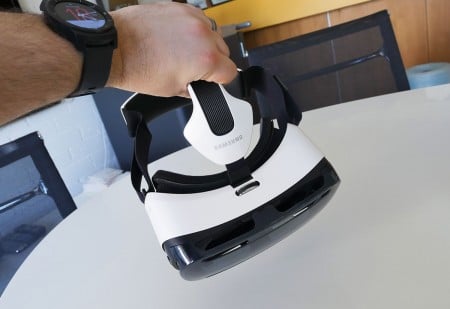Beyond the cinema app, you’ll find quite a few games available for you to play, including the demo game “Playhead” which demonstrates life inside of a music track and feels like an electronic music equivalent of Tron, “Anshar Wars” which lets you pilot a space fighter simply by aiming your head and touching the side of the Gear VR, “Temple Run VR” which is the same Temple Run you’ve played for ages but has you swiping to the sides to jump and dodge, and “theBlu VR” which is basically a small digital ocean that you can look around in.
We do need to note that some of these games work best with a gamepad, and while we suspect any Bluetooth gamepad will do, Samsung does make one, but it just hasn’t officially released it locally.
One day, maybe.
Finally, there’s a home menu beneath the main menu that you can get to if you need to check the time or want to look through the headset.
Sure, you could always just take the headset off, but why do that when you can hold the back button above the touchpad down for a few seconds and switch the passthrough camera on in that home menu. From here, you can also change the brightness, switch on a comfort mode with more yellow that might be better for your eyes, and fiddle with a do not disturb mode.
Throughout your time with the Gear VR, you’ll probably notice that while the Note 4 makes the sound, headphones would make this a better experience.
Interestingly, there are no built-in headphones for the Gear VR, and so if you want a more personal sound experience, best to plug in a pair to the Note 4’s 3.5mm headset jack, or use a Bluetooth pair. We went with the latter as it made the Gear VR very wireless and easy to use, just make sure you leave them hanging around your neck because it can be hard to see headphones in front of you when your eyes are covered with a display.
Another thing you may notice over time is the amount of strain the Gear VR puts on the bridge of your nose, because it is definitely noticeable. It’s not the sort overwhelmingly painful, but after 20 minutes, you will notice it, and eventually — close to the 45 minute mark — you’ll want to take it off.
Given the distance to the screen, you might want to take the Gear VR off every 15-20 minutes, so as to reduce the strain on your nose, but there’s also another part of your body that will feel the strain from wearing the Gear VR, and that’s your eyes.
There is a solution to this, though, and that is to use the head strap that comes across the top of your skull. This extra strap will make the Gear VR headset much more comfortable as the strap pulls the headset closer to your head, not only keeping your eyes in the dark needed to make the headset work, but also taking some of the weight off that nose, so that’s good.
Without the top strap, you’ll find you will get used to the weight over time, but we’d go with the strap. It’s easy to setup, can be removed quickly, and generally makes using the Gear VR comfortable, until you begin to focus too much on the clarity, or lack there of in the balanced sense.

Even though you have a dioptre adjustment wheel to play with, it never really feels like you’ve sharpened the text or visuals to point of perfection, at least not in the way we view without a screen. Some of the information will be sharp — generally in the centre of the lenses, because the outside is where the falloff is — but as you begin to read down and along the edges of the lenses, that is where your eyes will never really feel as if what’s there is in focus.
You get by after a while, though you should try not to focus too much on one thing, relaxing instead. We definitely advise taking breaks because even if you’re comfortable, your eyes will eventually feel the strain, especially as they adjust to real light again.
Some things may stop your viewing dead in its tracks, however, and one of them is heat and battery life.
The heat generated by the Note 4 is one thing that is next to impossible to get past, and we’ve seen it on Google Cardboard before, too, so we suspect this is just one of those things that will be ironed out in time with portable virtual reality headset.
Because the phone is being used as the screen and the computer throwing all of this information on screen, and because the screen is running with a solid amount of brightness and processing videos quickly while running the compass and accelerometer, you’ll find that you’re working the smartphone pretty hard.
As such, it’s not unusual to get a message telling you to stop using the phone because it’s heating up.
In fact, all you really need to do to learn this for yourself is to touch the phone, which will feel mighty toasty. You can get by this screen fairly easily by tapping the touchpad, which will make the message go away, but it will make itself known again and again, and it’s generally better to take it out of the Gear VR and let it cool down as an actual, you know, phone.












